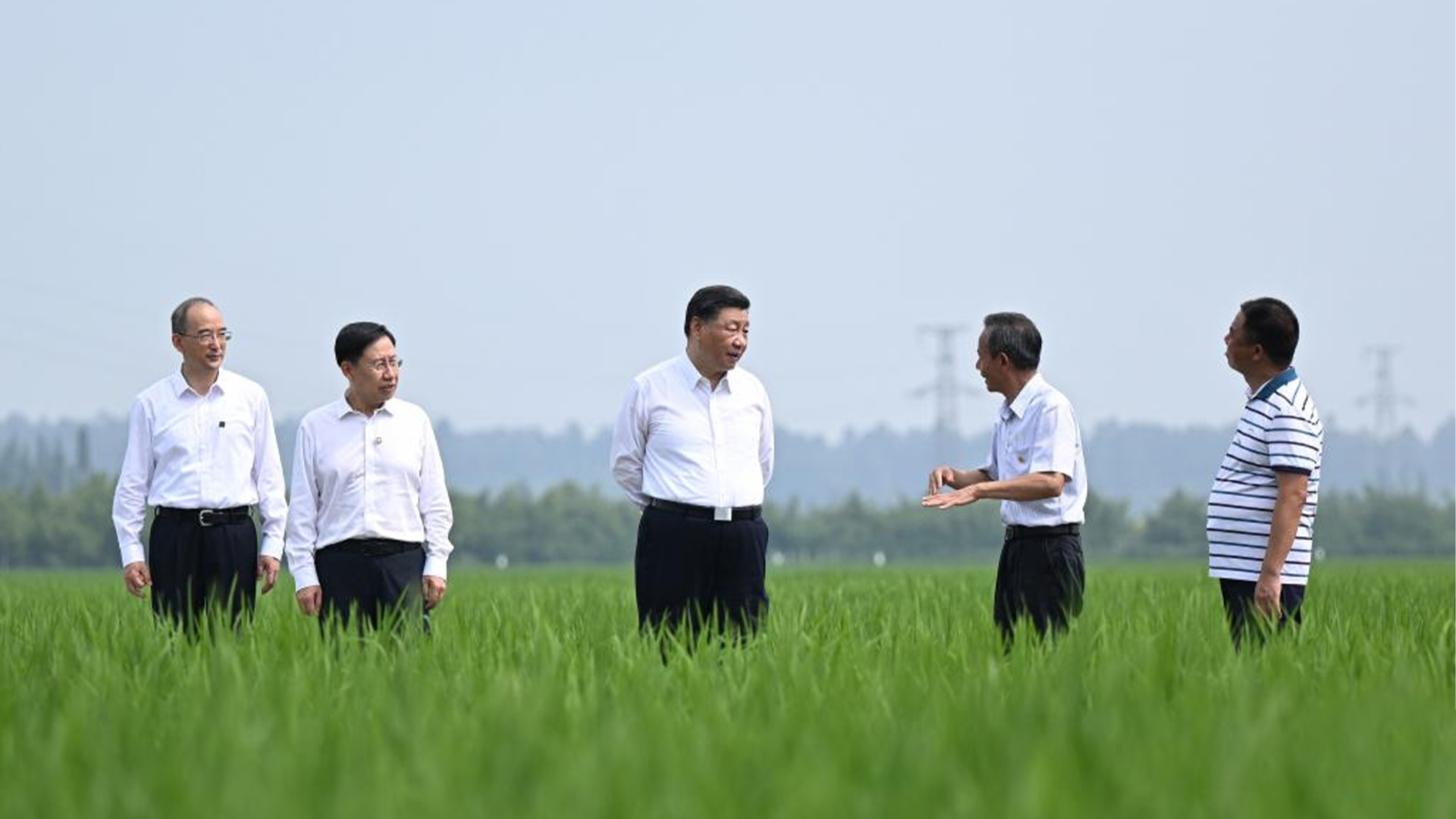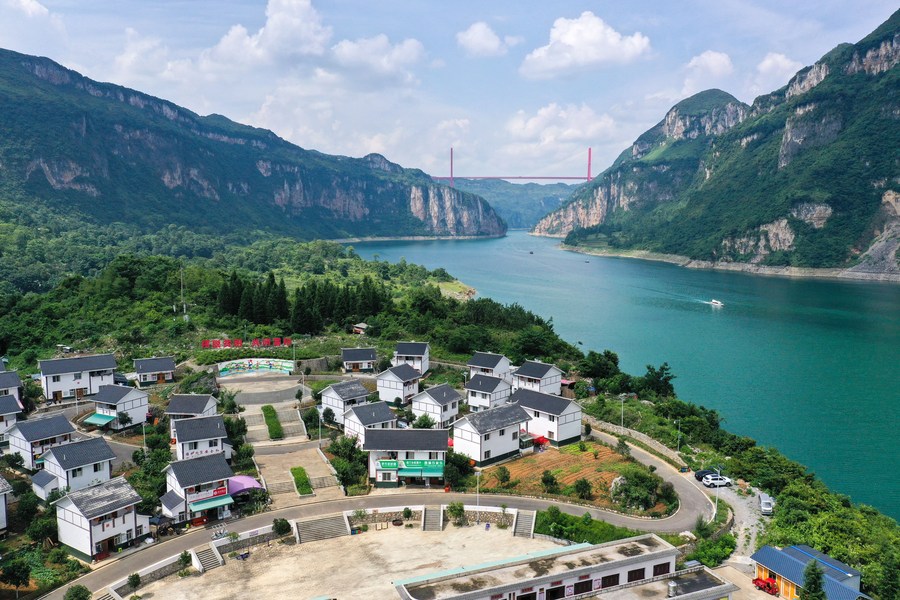
Chinese President Xi Jinping, also general secretary of the Communist Party of China Central Committee and chairman of the Central Military Commission, visits the village of Yongfeng to learn about local efforts in advancing high-standard farmland development, boosting grain production, promoting rural revitalization, maintaining effective COVID-19 prevention and control, in Meishan, southwest China's Sichuan Province, June 8, 2022. /Xinhua
Chinese President Xi Jinping, also general secretary of the Communist Party of China Central Committee and chairman of the Central Military Commission, visits the village of Yongfeng to learn about local efforts in advancing high-standard farmland development, boosting grain production, promoting rural revitalization, maintaining effective COVID-19 prevention and control, in Meishan, southwest China's Sichuan Province, June 8, 2022. /Xinhua
Editor's note: Xin Ge is an associate professor at the School of Public Economics and Administration, Shanghai University of Finance and Economics. The article reflects the author's opinions and not necessarily the views of CGTN.
Chinese President Xi Jinping, also the general secretary of the Communist Party of China (CPC) Central Committee, inspected the villages of Meishan in southwest China's Sichuan Province on June 8.
Since the 18th National Congress of the CPC in 2012, President Xi has prioritized work related to agriculture, rural areas and farmers, collectively known as "Three rural issues." Such matters are deemed as fundamental to the country's development andrural people's well-being. Just a few days ago, a book titled "On the Work of Agriculture, Rural Areas and Farmers" was published, which contains President Xi's 61 important discourses on rural work from December 2012 to April 2022, showing his sincere concern over the development of the countryside.
Rural revitalization has been a critical component of the Chinese government's work plan since it was brought forward in 2017. As President Xi put it, "The overarching goal ofthe rural revitalization strategy is the modernization of agriculture and rural areas." In 2018, the CPC Central Committee and the State Council jointly issued the 2018-2022 Strategic Planning for Revitalization of Rural Areas, which was followed by the establishment of a dedicated institution - the National Rural Revitalization Bureau (NRRB) in 2021, to continue providing service and improving the livelihood of rural people. The significance of agricultural and rural modernization cannot be overemphasized due to four major reasons.
First, the modernization of agriculture and rural areas is part of China's modernization progress. In February 2021, President Xi announced that China had secured a complete victory in the battle against poverty, by lifting 98.99 million impoverished rural residents out of poverty. As a result, China officially met the poverty eradication target set out in the UN's 2030 Agenda for Sustainable Development, 10 years ahead of schedule.
Hence, the focus of rural work shifted from poverty alleviation to overall rural revitalization, which incorporated both the socio-economic development of the countryside and the development of secondary and tertiary industries in rural areas, closely intersecting with some of China's other noteworthy goals, such as "Beautiful China," national green development push, ecological civilization, etc. The inclusion of green or sustainable growth is not only a requirement in the modernization of agriculture and rural areas, but also for the whole country.
Second, rural modernization can unleash the momentum for increasing job opportunities. At the rural work conference in December of 2021, President Xi stressed that the premise of rural revitalization is to consolidate the achievements of poverty alleviation. In particular, job opportunities are planned to provide for those lifted out of poverty.
As the head of NRRB pointed out, China strives to ensure the increase of employment for at least 30 million rural residents lifted out of poverty. Due to the continuous efforts to push forward rural modernization and offering employment opportunities, the average net income of people who have shaken off poverty is likely to have reached 12,500 Chinese yuan ($1,870), 16.5 percent higher than the previous year, according to official statistics.

A view of a relocation site for poverty alleviation at Huawu Village in Xinren Miao Township, Qianxi City, southwest China's Guizhou Province, July 24, 2021. /Xinhua
A view of a relocation site for poverty alleviation at Huawu Village in Xinren Miao Township, Qianxi City, southwest China's Guizhou Province, July 24, 2021. /Xinhua
Third, rural socio-economic development can reduce the gap in living standards between urban and rural residents. Better living environment, improved infrastructure and vigorous rural governance are essential for rural revitalization.
As early as 2003, when President Xi was the then Party secretary of Zhejiang Province, he launched the Green Rural Revival Program that focused on the concept of "lucid waters and lush mountains are invaluable assets." In 2018, the program earned the highest environmental honor of the United Nations.
China has placed a great deal of focus on improving infrastructure and essential public service in the countryside. To make the rural areas more livable, China launched a three-year living environment upgrade campaign in 2018. By the end of 2020, over 40 million rural household toilets had been renovated. In the meantime, from 2016 to 2020, more than 1.4 million kilometers of rural roads were constructed; and the total length of rural roads are planned to reach 5 million kilometers by 2035.
At the end of May, the CPC Central Committee and the State Council rolled out a special action plan, dedicated to rural construction, covering projects on roads, water supply, energy, logistics, housing, etc., to improve the production and living conditions in rural areas. On June 4th, China Development Bank announced that it has issued a total of 8 billion yuan (about $ 1.2 billion) of financial bonds to support the building of beautiful countryside, rural infrastructure and public services.
Last but not the least, prosperity of rural industries guarantees food security. President Xi has on various occasions stressed the importance of food security. The COVID-19 pandemic has heightened the uncertainties and instabilities of international agricultural trade, therefore alerted us to ensure the security of the supplies of grain and major non-staple foods.
For agricultural production, not only are more advanced self-reliant and self-developed technologies needed to improve the efficiency of farming and output, but arable farmland must be protected. The "Law on Promotion of Rural Revitalization," effective on June 1st, 2021, clearly states the "red line" of 120 million hectares of arable land and strictly bars farmland from being used for non-agricultural purposes.
Moreover, the National High-standard Farmland Construction Plan (2021-2030) aims to reach the target of 71.75 million hectares of "high-standard farmland" by 2025 and 80 million hectares by 2030. These efforts will ensure that "Chinese bowls are filled with Chinese grain and that Chinese grain is grown primarily from Chinese seeds," as President Xi put it.
Without agricultural modernization, rural areas cannot be fully revitalized; without rural revitalization, there will be no great rejuvenation of the Chinese nation. We believe that the modernization of agriculture and rural areas will definitely contribute to the construction of a great modern socialist country.
(If you want to contribute and have specific expertise, please contact us at opinions@cgtn.com. Follow @thouse_opinions on Twitter to discover the latest commentaries in the CGTN Opinion Section.)

